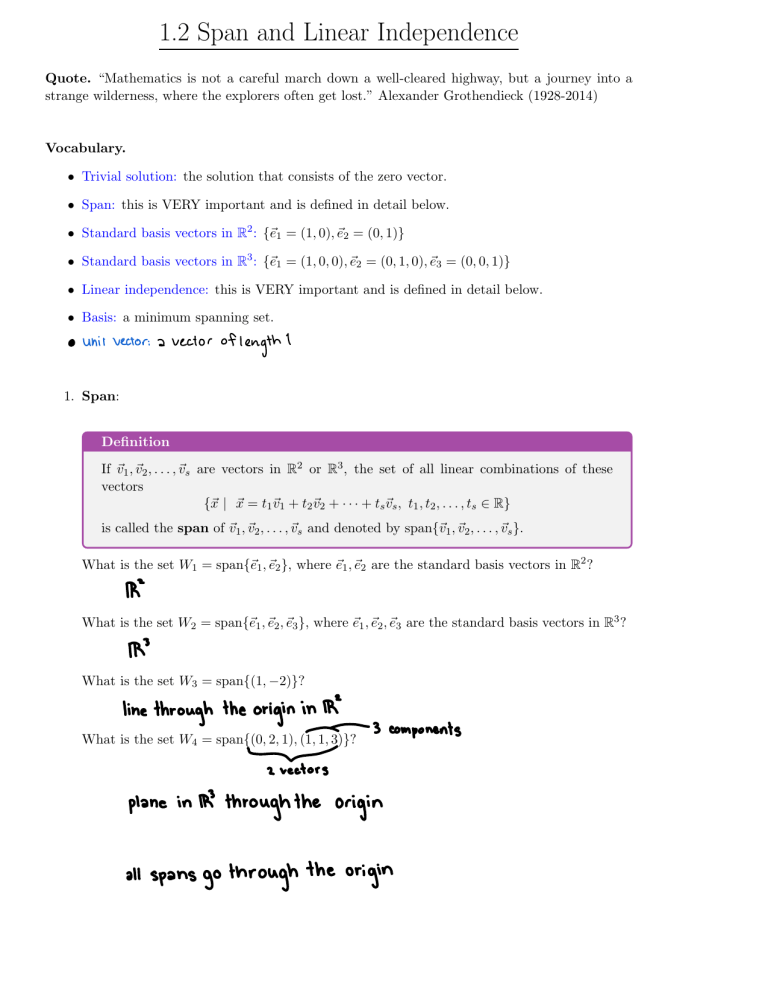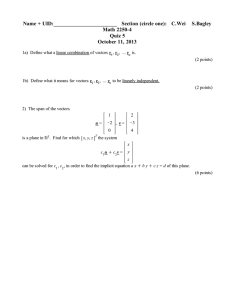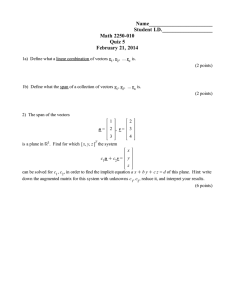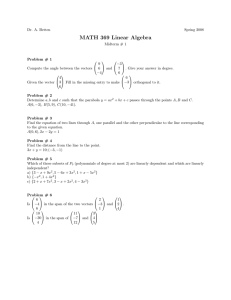
1.2 Span and Linear Independence
Quote. “Mathematics is not a careful march down a well-cleared highway, but a journey into a
strange wilderness, where the explorers often get lost.” Alexander Grothendieck (1928-2014)
Vocabulary.
• Trivial solution: the solution that consists of the zero vector.
• Span: this is VERY important and is defined in detail below.
• Standard basis vectors in R2 : {⃗e1 = (1, 0), ⃗e2 = (0, 1)}
• Standard basis vectors in R3 : {⃗e1 = (1, 0, 0), ⃗e2 = (0, 1, 0), ⃗e3 = (0, 0, 1)}
• Linear independence: this is VERY important and is defined in detail below.
• Basis: a minimum spanning set.
1. Span:
Definition
If ⃗v1 , ⃗v2 , . . . , ⃗vs are vectors in R2 or R3 , the set of all linear combinations of these
vectors
{⃗x | ⃗x = t1⃗v1 + t2⃗v2 + · · · + ts⃗vs , t1 , t2 , . . . , ts ∈ R}
is called the span of ⃗v1 , ⃗v2 , . . . , ⃗vs and denoted by span{⃗v1 , ⃗v2 , . . . , ⃗vs }.
What is the set W1 = span{⃗e1 , ⃗e2 }, where ⃗e1 , ⃗e2 are the standard basis vectors in R2 ?
What is the set W2 = span{⃗e1 , ⃗e2 , ⃗e3 }, where ⃗e1 , ⃗e2 , ⃗e3 are the standard basis vectors in R3 ?
What is the set W3 = span{(1, −2)}?
What is the set W4 = span{(0, 2, 1), (1, 1, 3)}?
2. Linear Independence
Suppose ⃗v1 and ⃗v2 are vectors in R3 . Consider the set
W = span{⃗v1 , ⃗v2 } = {s⃗v1 + t⃗v2 ; s, t ∈ R}
Investigate the set W for different vectors ⃗v1 and ⃗v2 .1
Definition
A non-empty set of vectors S = {⃗v1 , ⃗v2 , . . . , ⃗vk } in R2 or R3 (or as we will see in Rn )
is linearly independent if the only scalars c1 , c2 , . . . , ck that satisfy
c1⃗v1 + c2⃗v2 + · · · + ck⃗vk = 0
are c1 = 0, c2 = 0, . . . , ck = 0, i.e., the only possible solution (c1 , c2 , . . . , ck ) of the
above equation is trivial. If there are constants c1 , c2 , . . . , ck , not all zero, that satisfy
this equation, the set of vectors S is linearly dependent.
Are the following sets linearly independent?
(a) S = {(1, 0, 2), (0, 2, 0)}
(b) S = {(1, 0, 1), (0, 1, 0), (1, 1, 1)}
Suppose ⃗u and ⃗v are non-zero vectors. Are the following sets linearly independent?
(a) {⃗u}
(b) {⃗u, ⃗v , ⃗0}
1
In case you are interested in having a better vision of plane, you may visit here and select parametric
surface and insert the parameter equation of plane. Click here to see the result for span{(1, 0, 0), (1, 1, 1)}
for instance.
Theorem
A set S with two or more vectors in Rn is linearly dependent if and only if at least one
of the vectors in S is expressible as a linear combination of the other vectors in S.
Proof:
Corollary
(a) {⃗v1 , ⃗v2 } are linearly dependent if and only if ⃗v1 and ⃗v2 are parallel;
(b) {⃗v1 , ⃗v2 , ⃗v3 } are linearly dependent if and only if ⃗v1 , ⃗v2 , ⃗v3 lie in the same plane.
3. Checking Linear Independence
Are the vectors (−1, 2), (3, 4) linearly independent?
Are the vectors (0, 0, 1), (−1, 0, 1), (−3, 0, 5) linearly independent?
What do the above vectors span?
Can we express one of the vectors as a linear combination of the others?
And we imagine that we may need a more efficient way to do this! (coming in section 2.1)
4. Basis
Definition
A set of vectors ⃗v1 , ⃗v2 , . . . , ⃗vs in R2 or R3 is called a basis for R2 or R3 if
(a) span{⃗v1 , ⃗v2 , . . . , ⃗vs } = R2 or R3 ; and
(b) The set {⃗v1 , ⃗v2 , . . . , ⃗vs } is linearly independent.
Prove that the set {(−1, 2), (1, 3)} is a basis for R2 .
Consider the vector (1, 2) in relation to the standard basis and in relation to the basis above.
y
y
x
x



